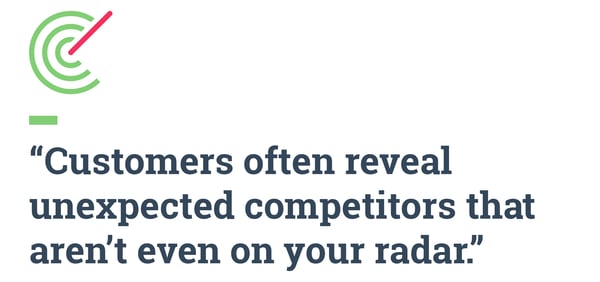How to Complete Your First Competitor Analysis
Imagine for a moment that you’re a professional boxer; you’re in your dressing room and it’s two minutes until the big fight. You can hear the roar of the crowd in the arena as they gleefully cheer in anticipation. The announcer calls your name; it’s time to go; you look down at your gloves, notice your pot belly and realise… You haven’t been training; you’re totally unprepared for this! But it’s too late; you’re ushered under the ropes as the bell rings, your opponent flashes you a knowing smirk before he leans back and floors you with one punch. Game over.
What I’ve just described is similar to what will happen if you enter the market blind, without conducting adequate research and assessing what you need to do to beat your competitors. Think of your competitor analysis as training for the big fight; without it, you have no chance of winning.
What is a Competitor Analysis?
Competitor analysis is the process of researching, categorising, and evaluating the strengths and weaknesses of brands that you deem to be a potential threat to your business.
By conducting a competitor analysis, you will gain knowledge and an understanding of:
- The market you operate within
- Your target audience
- Market forecasting and potential opportunities
- Competitor products & product development horizons
- Pricing structures
- Acquisition trends
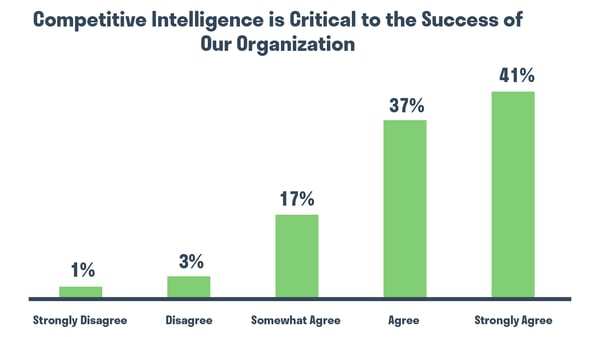
Source: Crayon
If you think all of the above sounds like a great idea, then follow our step-by-step tutorial of how to complete your first competitor analysis.
Step 1: Understanding the market your business resides in
Before you do anything, stop and answer me this: Do you really understand the market you’re about to enter? By this, I mean a deep understanding, not just the ‘top 10 trends for e-commerce this year’ type of understanding.
Knowing your market inside out is essential because it gives you the power of predictive thinking and avoids any significant legal or cultural blunders when it comes to your operations and marketing communications.
Design A Better Business has put forward a template for mapping the context of your market to give you an all-encompassing, 360° view of the market landscape. Using The Context Canvas guidelines, you will need to research the following areas of your marketplace, and record, analyse, and forecast how this information will impact the way you and your competitors will need to operate to be successful.
- Demographic trends
- Rules & regulations
- Economic environment
- Technology trends
- Customer needs
- Uncertainties
Be aware that your market is like a living creature; it’s constantly adapting and evolving. It is for this reason that you need to have a continuous view of the changes happening within your sector. Don’t create a content canvas this year and use it to inform your decisions for the next twenty years. Keep on analysing.
Step 2: Identifying your Competitors
According to Simplicable, there are 5 types of competitor:
- Direct
- Indirect
- Replacement
- Potential
- Future
HOTH adds a 6th competitor to the ranks: SERP (Search Engine Results Pages) competitors - these are SEO competitors; sites that compete to rank highly in google’s search results for the same keywords as you.

Source: DMN
For the sake of your first competitor analysis, we’re going to focus on the primary competitors that you will need to consider: Direct and Indirect.
How to identify direct competitors:
Your direct competitors are those companies who serve the same customer segments as your business with the same products or services as yours. There are several ways that your company can identify its direct competitors:
- Market Research:
Types of market research:
- Exploratory (primary research): aims to identify problems and opportunities, e.g., open-ended surveys or small-group surveys.
- Specific (primary research): seeks to solve these problems and find ways to avail of opportunities, e.g., surveys or focus groups with smaller, mo
- re specific segments of the audience.
- Public sources (secondary research): free sources of information, e.g., government statistics and census materials.
- Commercial sources (secondary research): market reports from research agencies such as Pew, Gartner, or Forrester, for example. This information requires payment to access.
- Customer Feedback
Your customers go on a journey when they purchase your product or service. On that journey, they will encounter other options to solve their problem, and those options are your competitors.
Source: Conductor
Once you gain the trust and confidence of your new customers, you should treat them as a fountain of knowledge into the world of possibilities outside of your business. Forbes highlights that 77% of consumers view brands more favourably if they seek out and apply customer feedback. Asking for feedback from your customers via surveys, polls, social media, etc., can even contribute to your overall customer retention rates.
- Social Media & Forums
Use social listening to find your competitors on the sites where your customers are searching for recommendations and advice. Configure your social listening tools to monitor specific keywords that are important to your industry, and you will be able to see which competitors your target audience are mentioning in recommendations.
The configuration of your social listening keywords is also vital as they can show you which of your competitors are successful in each stage of the buyer’s journey. For example, Search Engine Watch suggests adding synonyms and words such as “looking for” or “can anyone recommend” plus your product keyword to find awareness stage mentions of your competitors.
How to identify Indirect competitors:
Indirect competitors are those companies who serve the same customer segment as you and set out to solve the same problem but with different products or services.
There are many ways that you can identify your indirect competitors:
- Keyword research
Conduct an SEO competitor analysis (using a tool like GrowthBar) to find out who is competing for the same keywords as you on Google, the strength of their SEO strategy, and which authoritative domains are referring to their website. See our step-by-step guide here for advice on this process.
- SERPs analysis
SERPs stands for Search Engine Results Pages, and a SERPs analysis is simply the process of analysing the top 10 results returned for your company's chosen keywords. Content that is written around your keywords by influencers, businesses, and publications are all in indirect competition with your business, in terms of both revenue and web-traffic levels.
- Look at Paid Data
According to Store Growers, there are 5 essential questions when it comes to finding your indirect competitors with paid data:
- Which competitors are advertising on Google?
- How much traffic do they get?
- How much are they paying for these visitors?
- What are their most popular keywords?
- What are their most important metrics?
A simple Google search of your main keywords will show you which companies are placing advertisements in these areas, and you can use a tool like Similarweb to find out about their traffic and estimated spend. Or, if you’re already a pro at running your own ads, perhaps Google Ads is the one for you. Head to your Auction Insights report to gain a more detailed understanding of who your competitors are and how they operate their advertising campaigns.
Why is it important to consider both direct and indirect competitors?
Indirect competitors can become direct competitors, so you need to be on the lookout for rapid growth or pivots within indirect markets. Companies that serve your customer segments but with different products or services (or vice versa) are an increasing threat to your prosperity as technological advancements have reduced the time it takes for an indirect competitor to evolve into a direct threat.
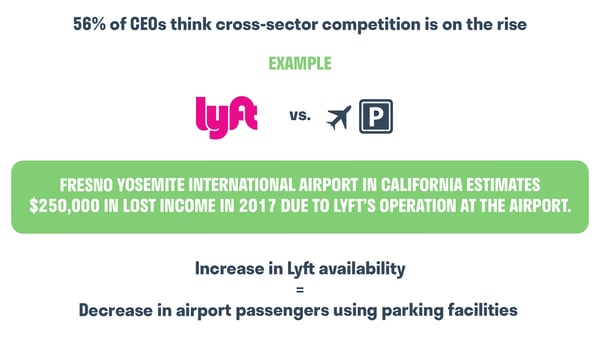
Source: PWC
Finally, at the end of step 2, you must pick 1-5 of your identified competitors to focus the remainder of your competitor analysis on.
Step 3: Record an overview of your competitor’s business
This step is all about getting to know the ins-and-outs of your competitor’s operations and their financial situation. Knowledge is power in this situation; if you’re unaware of details like how many employees a company has, how will you know how much effort is required on your part to out-market them?
There are 3 categories to consider:
- Operations
This information is generally public and easy to locate; you will be able to find most of the data you need via your competitor’s website and their company LinkedIn profile.
- Company name + domain
- Social media handles
- CEO / Founder information
- Head of Marketing information
- Number of employees
- Offices & locations
- Job openings
- Funding
Your funding section will be particularly important if you’re working within SaaS or the startup market. Using sites such as Crunchbase, you will be able to discover your competitions’ funding history.
- Money raised
- Current funding round
- Investors
- Revenue
Now, this part is a little bit tricker than the previous sections. Companies don’t exactly publish their revenue details publicly. Unless they’re absolutely smashing it, that is, in which case you’ll likely be able to find masses of data on how great they’re doing from their PR humble-brags.
- Customers
- Year-over-Year (YoY) customer growth
- Annual revenue
- YoY revenue growth
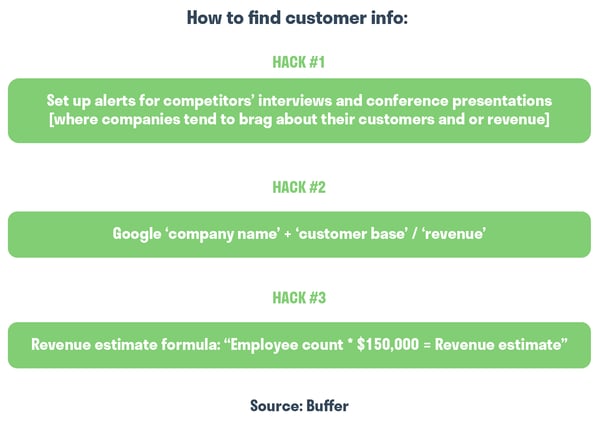
Step 4: Use the feature comparison matrix to compare your products and offerings
A feature comparison matrix is a straightforward, visual way to compare all of the common and unique features of your competitor’s products. It helps you to identify market opportunities and areas for product development.
Do all of your competitor’s products have a feature that yours does not? You could be losing out on customers who desire this feature. Or, does your product offer something that no other competitors do? Galvanise upon this uniqueness in your campaigns to differentiate yourself from competitors.
![]() Source: TechAdvisor
Source: TechAdvisor
The features & categories analysed in your matrix will change depending on your industry, products, and the needs of your customers. Ultimately, you need to ask yourself; how well does the product fulfil the needs of the customer segments it serves?
Finally, you should consider what technology your competitors are using to create, manage, and streamline the promotion and use of their product, plus any customer service technology they use as part of their retention strategy. When researching the tools used by your competitors, you can utilise sites such as SimilarTech to spy on their digital solutions.
Step 5: Use the RACE acronym to conduct an in-depth content analysis
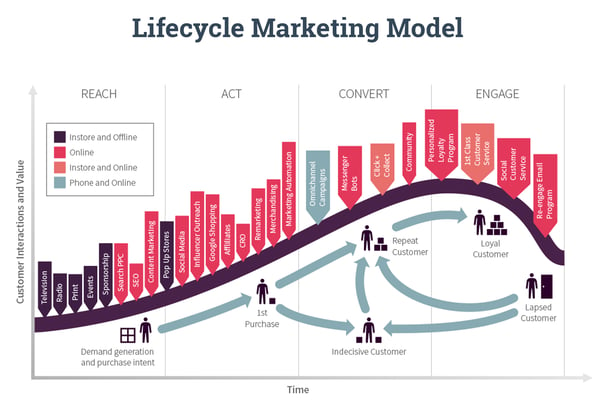 Source: Smart Insights
Source: Smart Insights
The RACE acronym was introduced by Smart Insights; RACE stands for: Reach, Act, Convert, Engage.
- Reach
This area of your content analysis will cover all of the avenues where your competitors draw in traffic and create awareness about their brand and products. Reach can extend into multiple channels, so it will help if you ask yourselves the following questions:
- How is my competitor’s reach split between online and offline?
- Which methods of traditional marketing outreach do they use? (television ads, radio ads, direct mail outreach, billboards, PR, etc.)
- Which methods of digital marketing outreach do my competitors use? (organic SEO, PPC, Influencer deals, content marketing, etc.)
- Are their marketing communications of high quality? Is content accurately proofed, socially conscious, memorable, eye-catching, repetitive, consistent with the overall brand, etc.?
Make a spreadsheet and record details of each method of outreach used by your competitors, and the success they see with each (where possible). Compare this data to the methods that your marketing team employs. Are there gaps in your tactics? Consider whether investing in these outreach channels is worthwhile for your business.
- Act
Consider how your competitor’s processes, technologies, content, and communications force their customers to act. Customer actions can range from making a purchase, sharing social media content, leaving a review, telling a friend, etc. Here are some starting points that you will want to address:
- What journey do your competitor's customers take when purchasing from this brand?
- How many different touchpoints do they encounter on their buyer’s journey?
- What value do they offer in exchange for customer data? For example, blogs, guides, ebooks, discounts, etc.
- What lead-generating tools are currently in use?
- How does tone-of-voice in content and call-to-actions impact the actions of their customers?
- Convert
When your competitors’ customers arrive at the decision stage of their buyer’s journey, what persuasive devices are used by sales and marketing to close the deal? Assess the quality and persuasiveness of their decision stage content, and don’t be afraid to sign-up for their email newsletters and fill-out forms to get a real insight into their process. Snooping is a useful tool when it comes to content analysis.
Be on the lookout for:
- Landing pages
- Live demos
- Free trials
- Free shipping
- Discounts
- Remarketing adverts
- Abandoned-cart campaigns
- Engage
It’s improbable that your competitors will focus all of their energy on their acquisition strategy - if they do, they’re probably not much competition at all because their customers won’t be loyal. Thus, they will be much easier for you to take. Assess the customer retention strategies of your competitors to figure out why their loyal customers are just that loyal.
Customer retention strategies include:
- Onboarding
- Email marketing
- Loyalty schemes
- Gamification
- Push notifications
- Customer feedback
Step 6: Act on the information you gather
Look at you! You’ve made it to step 6, well done. I know that it took a lot of hard work, research, and downright detective work to get you here. So, now that you’ve arrived, let’s make sure all your work wasn’t for nothing. By now, you probably have a massive spreadsheet, full of data points and razor-sharp analysis, but what does it all mean for you? Step 6 is the part of your competitor analysis where you use the information you have gathered to shape your strategy going forward.
Did you discover a product feature that your competitor has and their customers are raving about, but that you’ve never even considered? Well, then I think it’s time for you to start developing your product with this in mind. Or, maybe you found out that your indirect competitors are gaining tens of thousands worth of traffic each month from Google Ads using your keywords! Time to start bidding against them and win back your traffic, don’t you think?
To conclude your competitor analysis, list the factors you have identified that you want to add to your marketing strategy. Create goals and objectives to ensure you implement these factors promptly and can analyse the success or failure of these new factors when the time comes.
And there you have it, your first competitor analysis is complete! Now all that there’s left to do is mark a date in your calendar for your next one… This is an ongoing process, not a one-time deal, so you best get used to conducting this analysis, and reaping the rewards of doing so.
Share this
You May Also Like
These Related Stories

Maximize your Keyword Research with SEO Competitor Analysis

4 Stepping Stones to a Successful Competitor Analysis
.jpg)

